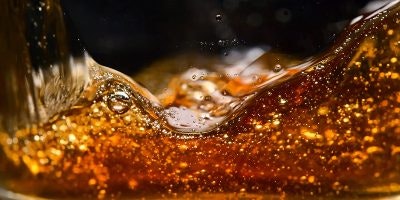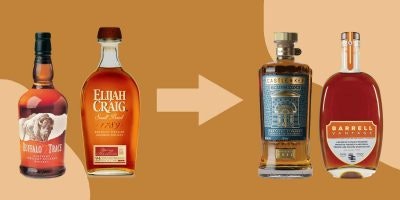The whiskey industry today is vast. It’s larger than anyone can imagine, with countless expressions made by producers all over the world, each with their own unique story. Single malt whisky, bourbon whiskey, rye whiskey, Japanese whisky—whiskey styles are vast.
Each category has its own unique production methods, maturation periods and cask usage. Some whiskeys are distilled using uniquely shaped stills; others mature at high altitudes. There’s a whole lot going on, and anyone just getting into whisk(e)y will need to do some serious homework. How else can they hope to keep up with the educated barflies that occupy their local whiskey spot?
A SIMPLER TIME
Believe it or not, there was a time when the whiskey industry was much more straightforward. A time when several common traits helped categorize the products.
Scotch ads from the ’50s and ’60s
Typically, Scotch whisky producers aged their whiskies in sherry and/or bourbon casks. Bourbon aged in new, charred American oak and nothing else. And Japanese whisky producers followed similar practices as the Scotch.
Unlike today, we categorized whiskey primarily by age. Right or wrong, the age of a whiskey determined how expensive and how luxurious it would be. Consumers considered blended whiskeys and whiskeys in the U.S with no age-statements (NAS) as more commercial, cheaper, and lower quality options.
Nowadays, younger releases are widely accepted. Yet in the recent past, consumers of Scotch whisky wouldn’t have accepted a single malt that had aged for less than 10 years.
It was a very different time. But markets evolve, and a huge change was on the horizon.
THE WHISKEY DROUGHT IN THE NEW MILLENNIUM
Just over a decade ago, news broke that aged whiskey was starting to run out.
Consumption and demand was rising faster than whiskey producers had anticipated, and while this was great news, it came with a major setback.
Whisky barrels at the Yoichi Distillery / Photo Credit: Nikka
Major whiskey-producing countries simply hadn’t put enough whiskey in barrels for maturation decades before.
Nikka, a major Japanese whisky maker, even stopped making whisky for a period of two years, back when whisky consumption in Japan was at an all-time low.
Suddenly, whiskey warehouses around the world started to look a little bare. But large producers were faced with a consumer base thirsty for high-quality, aged whiskey. A new solution had to be found, as whiskey makers were at last witnessing their hard work paying off.
The image of whiskey was changing, no longer just an old man’s drink, as many once described it.
So distilleries turned to no age-statement whiskeys.
NAS WHISKEY
Whether blends, bourbons or single malts, these NAS labels don’t feature a number stating the minimum years the whiskey has aged. The idea was that an NAS bottle would allow producers the world over to enjoy steady growth, while the whiskey in their barrels aged peacefully.
Whiskey consumers, however, were used to a big bold number on the bottles they bought. The lack of said number spoke of an assumed lower quality product; a young spirit that hadn’t yet fused with the oak it rested in.
Yet, despite protests, distilleries had no other choice but to follow the NAS path.
THE JAPANESE RESPONSE
Across the ocean, Japan’s aged whisky drought was much more severe.
Decades before, Japanese whisky companies had only the domestic market in mind when adding whisky to barrels for aging. What’s more, their domestic market wasn’t even thirsty for whisky, as consumption in Japan shrank to one-third of its size between 1980 and 2005.
Whisky barrels at the Miyagikyo Distillery / Photo Credit: Nikka
As a result, when consumption started rising once more, Nikka had to discontinue their popular, aged Yoichi and Miyagikyo ranges. They were replaced with a Yoichi and a Miyagikyo single malt with no age-statement.
Suntory, Japan’s largest whisky producer, greatly reduced the production of aged releases.
As a replacement, the Yamazaki Distiller’s Reserve, the Hibiki Japanese Harmony, and the Hakushu Disiller’s Reserve were brought on to the market. No age, just a promise of taste and quality.
Aged expressions rose greatly in price, and NAS releases have become the norm.
EXPERIMENTATION
However, we mustn’t forget that the whiskey world is known to be a warm and inviting one. The last thing whiskey makers wanted was to isolate their fans, overcharge them and supply them with products of lower quality.
Chichibu Card Series/ Photo Credit: Japan Whisky Tours
So, experimentation kicked off.
Producers started aging and finishing releases in casks not usually used for whiskey maturation.
Think white wine, red wine, brandy, port and even rum casks. Some might argue that this also happened in the past, when whiskey producers felt like doing something different. Yet, in order to excite fans disappointed with the new era of NAS whisky, these uniquely finished whiskeys have spread notably.
The Chichibu Distillery in Japan is a prime example. Founder Ichiro Akuto specializes in creating young releases, often aged in unique casks. Their latest release aged in a cask which previously held an India pale ale. Chichibu’s releases sell out quickly, and what’s more, the price tags of these releases are substantially high. This shows that the consumer mentality is changing towards NAS whiskey.
Nikka recently announced two single malts finished in Moscatel Portuguese fortified wine casks, and two finished in rum casks, all NAS releases.
NOT JUST SMALL PRODUCERS
Over in Scotland, cask-finished releases are exploding too. Glenfiddich, producer of one of the world’s best-selling single malts, added an IPA-finished single malt to its new Experimental Series. The latest release in the series was announced recently, and is a single malt finished in Canadian ice wine casks.
Glenfiddich IPA / Photo Credit: Scotch Trooper
Even more recently, at the end of September, the Glenfiddich announced the new Cask Collection Finest Solera, which is a no age-statement single malt that will retail at a staggering $2,000.
With such a price tag attached, it’s clear that NAS releases featuring unique cask finishes is not only being widely accepted, but is beginning to overtake aged whiskey expressions in terms of price and appeal.
And all of the releases mentioned above have come to us in 2017 alone. It’s impossible to mention each and every uniquely finished whiskey from previous years, as there are simply too many to detail. But we’ve done some round ups if you’d like to take a look. Here. And here.
THE FUTURE OF WHISKEY
The return of readily-available aged expressions is near. Producers didn’t make the same mistake twice, and filled more than enough casks at the start of the 21st century.
The question is, what will happen when these matured releases come back to claim their old status? Will consumers lean towards exotic cask finishes and new flavors over age statements?
Or will whiskey’s fame spread even further, as two different consumer bases, lovers of old and new, come together to enjoy some well-aged, uniquely finished drams?
That’s a future we’re hoping for.
With Distiller, you’ll always know what’s in the bottle before you spend a cent. Rate, Review, and Discover spirits! Head on over to Distiller, or download the app for iOS and Android today!



